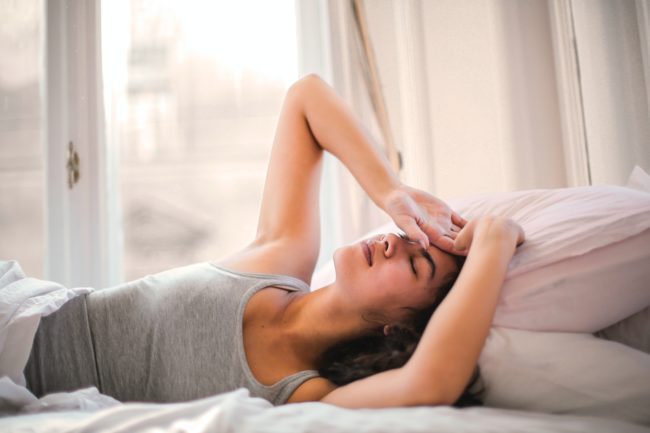
Migraines can be hell. Most of us that suffer from them look for any form of relief that we can. Below is a guide to some of the common triggers so that you can prevent a migraine, as well as tips on beating a migraine once they’ve started.
What is a migraine?
Migraines are severe headaches that in some cases can also result in nausea, vomiting and extreme sensitivity to light and sound. They affect about 1 in 5 women and 1 in 15 men (they’re very common!).
Migraines are different from tension headaches and other types of headache in that they tend to only affect one side of the head. They often develop gradually, starting off as a mild headache and then getting severe (an extreme headache with no build-up is probably worth seeing a doctor for as it could be a sign of something more worrying). Regular migraines often don’t require medical attention, although some people have such severe pain that they resort to calling an ambulance.
What causes migraines?
The exact cause of migraines is still a mystery. It’s believed that they are the result of temporal changes in the nerves and blood vessels around the brain. More often than not, migraines are genetic.
In the case of regular migraines, there are usually specific triggers. Because of this they can be treated much like an allergy – by avoiding certain triggers, you can prevent migraines from occurring.
Common triggers of migraines
Migraine triggers come in all forms. Some of the most common triggers include:
· Stress
· Food triggers (common specific foods include chocolate, processed meats, breads, matured cheeses, ice cream and foods with MSG in)
· Drink triggers (common specific drinks include caffeinated drinks and alcoholic drinks)
· Changes in sleep schedule (some people experience the ‘weekend migraine’ after lying in on a Saturday)
· Certain medication (ibuprofen, aspirin and sleeping pills can trigger migraines for some people)
· Changes in weather
· Sex (some unlucky people experience a migraine after having an orgasm)
To identify triggers, it’s worth keeping a migraine diary – every time you have a migraine, write down everything you consumed or did before the headache set in. By spotting trends, you can then start to work out what your triggers are so that you can avoid them.
It may not always be possible to avoid all triggers. Changes in weather for instance are completely out of our control and as a result are one of the more frustrating trigger types.

How To Beat A Migraine
Once a migraine sets in, there’s often no choice but to ride it out. That said, some people do find odd ‘miracle’ cures that work for them. There are also ways to reduce the pain and make it more manageable. Below are just some of the best methods for dealing with a migraine.
Take some painkillers
Over-the-counter painkillers may be able to offer some pain relief. They’re most effective when taken at the beginning of a migraine, often preventing a migraine from reaching its full force.
It’s important to exercise caution when taking painkillers. Never take more than the recommended dose (no matter how bad the headache may feel) as an overdose could be deadly. You should also be careful of taking certain painkillers together – while you can take ibuprofen and paracetamol together to double the effectiveness, there are certain combinations like aspirin and ibuprofen that are dangerous. You can find information on which painkillers can be mixed online.
Try other pain relief supplements
There may be other supplements that you can take to try and ease the pain. You may be able to take these with over-the-counter painkillers or you could take them as an alternative if you don’t like popping pills.
CBD is one supplement that has become particularly popular as a form of pain relief. This ingredient is extracted from the cannabis plant – offering the pain-relieving effects of the plant, but without the high of the drug. CBD can be taken in many forms from pills to gummies as you can see with this list of vetted products. You can even apply topical creams and gels.
Lavender oil is also popularly used to fight pain and can be particularly effective against migraines. This oil can be applied directly to the temples in a diluted form or it can simply be inhaled by using an oil diffuser. Some people find that peppermint oil has a similar effect.
Ginger could also be worth trying if you tend to find that migraines make you nauseous. This common household herb has long been used to fight pain and cure nausea and has numerous studies to show its effectiveness. In fact, one study found that ginger was just as effective at fighting migraines as the over-the-counter painkiller sumatriptan.
Relieve tension around the head
If you’ve got your hair up, consider letting it down. If you’ve a hat or a headband on, take them off. Anything that is causing tension on the head could be making the pain worse, so try to keep the head free of any restraints. Some people find that cushioning the back of their head with a pillow helps, while others may find that even this adds pressure to the head and makes the migraine worse.
Escape to a dark, quiet room
Many migraine sufferers experience extreme sensitivity to light and sound. Exposure to this can make the headache worse. If you’re at home and you feel a migraine coming on, it could be worth heading straight into the bedroom, shutting the door and closing the curtains. Lie on the bed and close your eyes – it should help the migraine to ease off. If you catch it early enough, you may even stop it from developing into a severe migraine.
Some people go as far as wearing earplugs and an eyemask, however for others having this extra stuff on one’s head makes the migraine worse.
Drink lots of water
Migraine sufferers have been found to be more sensitive to dehydration and in some cases it can be a migraine trigger. By drinking enough water throughout the day, you may be able to prevent a migraine. Meanwhile, drinking lots of water after a migraine has already set in could also help to ease the pain. It’s especially important if a migraine has caused you to throw up, as vomiting will make you more dehydrated.
As soon as a migraine sets in, pour yourself a couple glasses of water. If you decide to lie down in your bedroom to ease the pain, consider taking these glasses with and regularly sipping on them.
Try a cup of coffee
Surprisingly, some people find that drinking a couple sips of coffee can ward off a migraine. This is believed to be the effect of the caffeine on the nerves and blood vessels in the brain. Most people find that this works only in the early stages of a migraine.
Caffeinated drinks can of course be a trigger for some people – if coffee causes you migraines, then this is definitely not the pain relief strategy for you.
Try taking a hot bath
Hot baths are often recommended by doctors as a form of DIY pain relief. They help to relax muscles and relieve inflammation in the body, which commonly contributes to pain. If you feel a migraine coming on, consider running yourself a bath.
Alternatively, you could try placing a hot wet flannel over your head to directly target the area. A warm compress will also help to reduce inflammation and relieve pain.
Try a cold compress
It’s not just the heat but also the cold that can help ease a migraine. Compressing an ice pack or a frozen bag of vegetables onto the head can offer some direct relief. This is because the coldness has a numbing effect, which can dull the sensation to pain.
For maximum impact, apply the ice pack for 15 to 20 minutes at a time to the base of the skull. There are ice neck wraps that you can buy that can help to offer a cold compress. These could be worth buying and trying if you regularly get migraines.
Get a massage
Some people find that a head massage can clear up a migraine. By stimulating nerve endings around the head, it can reduce the pain.
You could get someone else to give you a massage or you could try to give yourself a massage. There are guides and videos online that can teach you how to perform such a massage.
If you need to throw up, do it
For some people, being sick has the effect of almost instantly curing a migraine. Many people experience nausea when having a severe migraine – if you get the urge to be sick, it could be worth giving in to that urge. Some people even go as far as inducing vomiting just to beat a migraine. There are a number of hypotheses as to why vomiting may stop a migraine, however researchers are still unsure as to the exact link.



